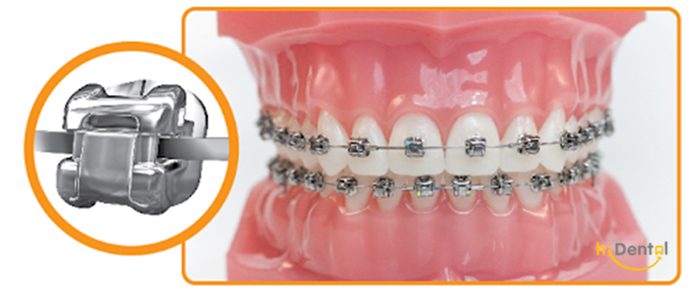Mục lục
Few people are lucky enough to be born with perfect teeth, but orthodontic treatment can make a huge difference to you or your child. Your orthodontist may recommend any of the following types of braces or dental appliances such as traditional braces, damon braces, invisalign, lingual… to help correct your particular problem.
Each type of brace has their own advantages and disadvantages, and today we’re investigating the differences between damon braces and traditional braces.

HOW DO BRACES WORK?
To understand the differences between traditional and damon braces, you need to know the principles that govern all orthodontic appliances.
Braces work by putting pressure on your teeth, with the aim of aligning them. This pressure stretches and compresses the ligament that holds your teeth into your gums, moving the teeth slightly in the desired direction.
TRADITIONAL BRACES

Traditional braces have progressed since the early days. They are made from a high-grade stainless steel and have metal brackets that are attached to each tooth using a type of cement. The brackets are linked to each other with a thin archwire, which puts pressure on the teeth to cause them to move slowly into the correct position.
The archwires are connected to the brackets using tiny elastics known as ligatures or o-rings, which your orthodontist will change each time he tightens the braces. The main issue cited with this method is the friction caused between the brace and the wire, which can cause significant discomfort for the wearer.
This is the type of braces that most teenagers get, because they are the least expensive version and ability to choose the color of the rubber bands around each bracket, as this gives each person an opportunity to personalize their braces. They are also strong and hard to “break”.
Some types of braces have brackets that don’t need o-rings, and these are called self-ligating braces.
DAMON BRACES

Damon braces may seem like a new technology, but in reality self-ligating brackets like Damon braces were first conceived as long ago as 1935. Damon braces are more formally known, was introduced in 1996 by Dr Dwight Damon. The main differences between Damon braces and traditional ligation braces is the way that the wire is held to the brackets on your teeth. Damon braces are self-ligating and use a slide mechanism instead of elastics to connect the archwires.

Damon Braces claim that this results in a treatment that requires less trips to the orthodontist to tighten the wires. These braces produce also faster results because the teeth can move on their own without needing to be adjusted. This causes less friction and pressure on the teeth, so movement is less painful. The braces are also easier to keep clean. A new clinically proven treatment approach that aligns your teeth and enhances your facial aesthetics without extractions or rapid palatal expanders.
Because of many advantage, the treatment with damon braces is more costly than in the traditional braces case. While they do shorten treatment periods, they might not provide all of the features that a patient needs in order to have a successful orthodontic treatment. So they are not the right choice for every patient.
CONCLUSION

It is impossible to find any procedure that doesn’t come with some disadvantages. For that reason, it would be erroneous to claim any one system is better suited for everybody. Your dentist’s interpretation of your aesthetic desires and their skills and understanding of the available technology will be the deciding factor in the quality of your results. That’s why it’s so important to choose your dentist with care, and to find one with good experience in your chosen treatment who makes you feel comfortable and confident.

